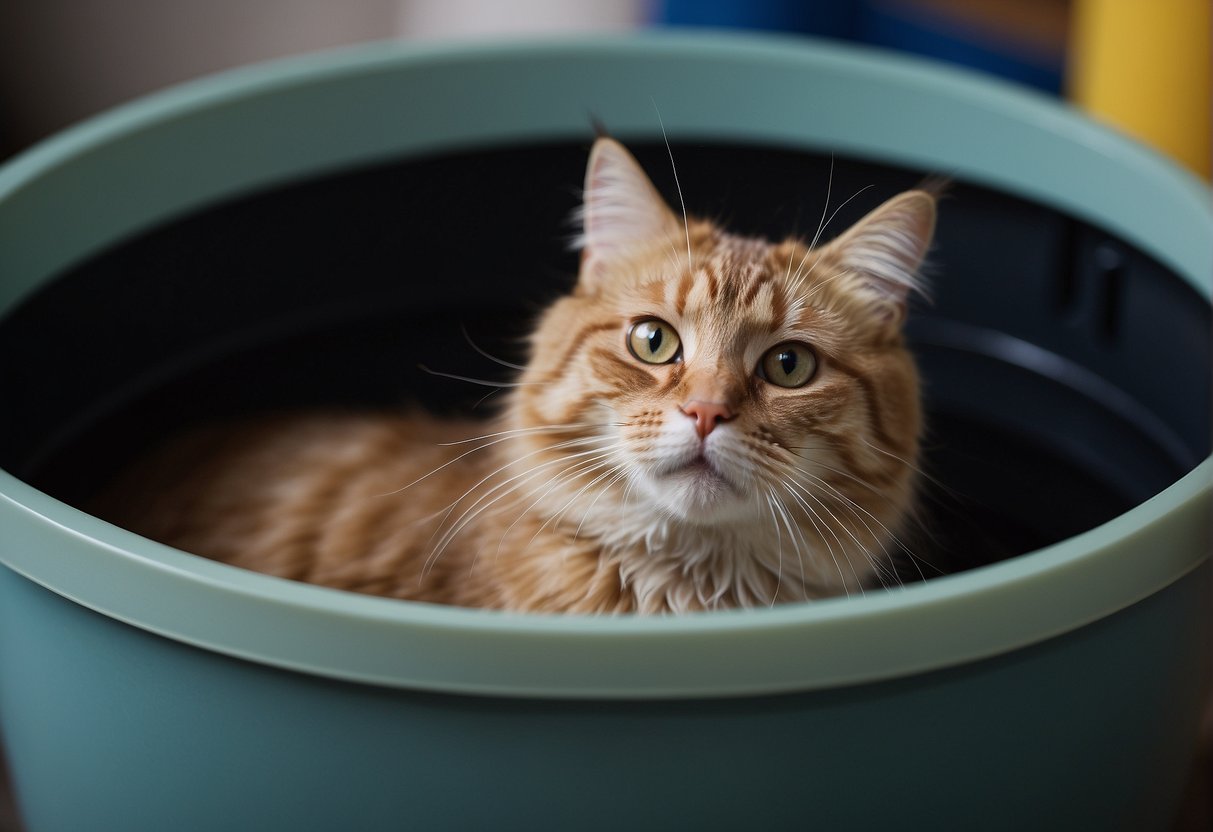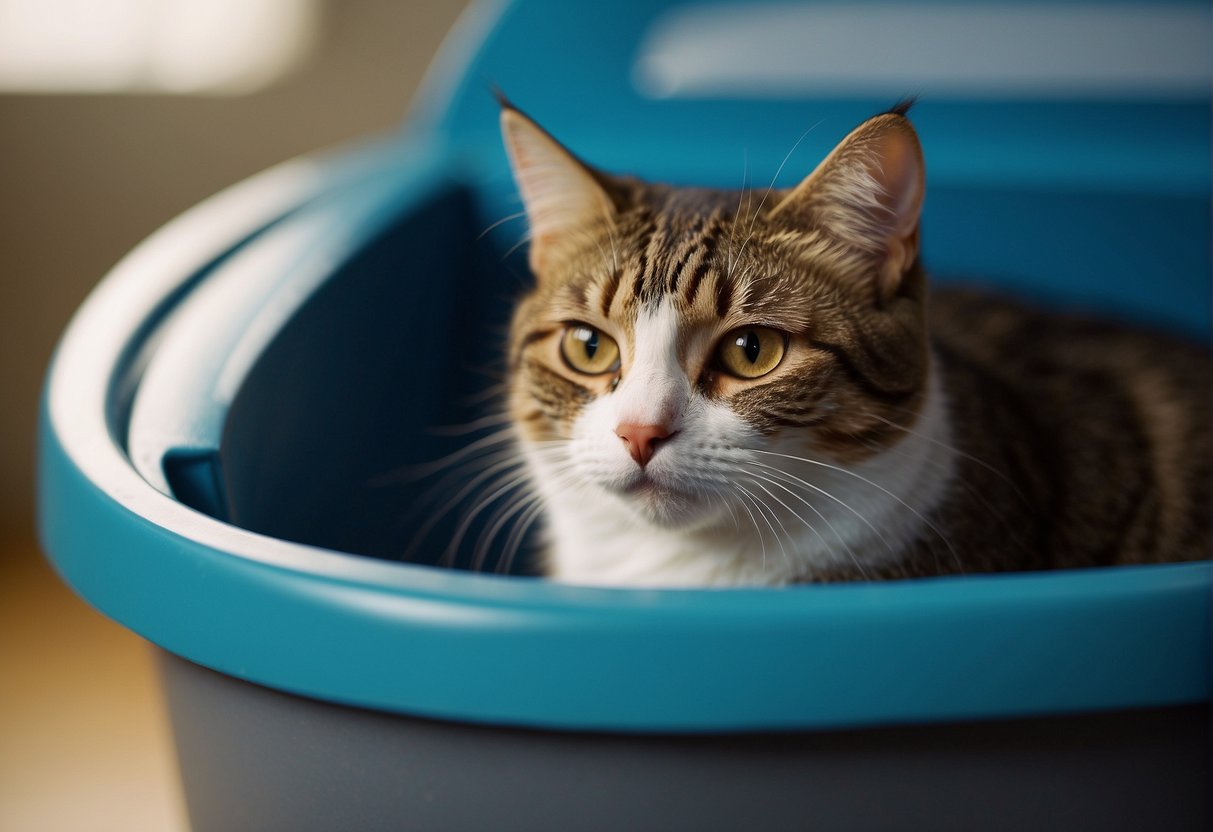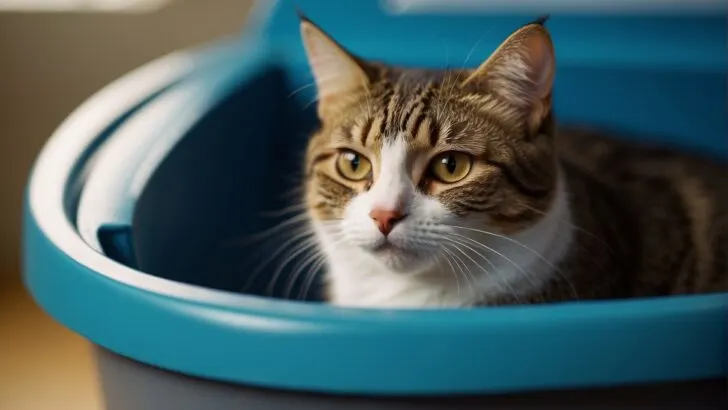Cats, like humans, can experience constipation, a common digestive issue where they have difficulty passing stool or do not go to the bathroom as frequently as they should.
Just like that time my little buddy prowled around the house restlessly, you may notice your cat is spending prolonged periods in the litter box with little success. If your normally fastidious feline friend suddenly starts to avoid the litter box, it could be an indication that something is amiss with their bowel movements.

Under these situations, other signs your cat may display include visible straining, a decrease in appetite, or even a bit of crying or discomfort around the litter box area.
It’s concerning when your active companion becomes less playful and seems fatigued, which was the case when my cat was lazing around more than usual, a stark difference from its regular bursts of energy.
Knowing whats up with your cat’s toilet habits can be tricky, but a good rule of thumb is to monitor how often they’re passing stools. Normally, cats should have a bowel movement at least once every 24 to 48 hours.
However, if you notice fewer clumps in the litter box over a couple of days or if your cat seems unusually tired, it’s worth considering that they might be constipated.
Recognizing the Signs of Constipation

As a cat owner, it’s important to be aware of the subtle shifts in your cat’s routine and behavior that may indicate constipation. From their demeanor to their physical symptoms and litter box habits, each clue can help you ensure your cat’s health and comfort.
Behavioral Changes
One of the first things you might notice is a decline in your cat’s energy levels. If your normally playful feline is showing signs of lethargy or seems less interested in engaging with you or their environment, it could be a signal they’re not feeling well.
Cats often hide when they’re in pain or discomfort, so if your cat is tucking themselves away more frequently, take note. Also, a hunched posture can be a telltale sign of discomfort, possibly related to abdominal pain.
Physical Symptoms
When it comes to physical signs, straining to defecate without producing much or any waste can be a clear indicator of constipation.
You might also notice the appearance of small, hard stools, if any, which suggest dehydration and difficulty passing waste. Additionally, if you observe any signs of abdominal pain, such as yowling or resistance to being touched, or instances of vomiting, these symptoms should prompt immediate veterinary attention.
Litter Box Clues
Finally, keeping a vigilant eye on your cat’s litter box can reveal critical insights. A decrease in the frequency of stools, or a complete lack of stools, is a major red flag. If stools are present, they may appear concentrated and hard or dry.
Any effort by your cat that results in prolonged straining or discomfort in the litter box, especially if accompanied by crying or other vocalizations, must be addressed.
Understanding the Causes Of Constipation In Cats
It’s crucial for you as a cat owner to recognize that constipation in your feline friend can often be traced back to their diet and overall health condition.
Diet and Hydration
Diet plays a pivotal role in your cat’s digestive health. Low dietary fiber could be a significant factor. If your cat’s diet lacks sufficient fiber, the digestive system might struggle to keep things moving smoothly. Incorporating the right amount of fiber can help, but it’s a delicate balance—too much fiber can be just as problematic.
- Hydration is another significant factor. Cats on a dry-food diet may experience dehydration more readily, which, in turn, can lead to constipation. Introduce more wet food in their diet or provide a cat water fountain to encourage better water intake and hydration.
| Diet Factor | Suggestion |
|---|---|
| Low Fiber | Add more fiber |
| Dry Food Diet | Include wet food |
| Low Water Intake | Provide clean water sources |
Health Conditions
Several underlying health conditions can contribute to your cat’s constipation:
- Kidney disease can lead to dehydration and consequently constipation. It’s essential to keep an eye on your cat’s water consumption and consult your vet if you notice any concerning changes.
- Obesity can profoundly impact overall health and mobility. Excess weight may make it difficult for your cat to position themselves effectively in the litter box.
- Arthritis or other mobility issues may prevent your cat from being able to squat properly, leading to hesitance in using the litter box.
Other conditions such as hyperthyroidism, diabetes, inflammatory bowel disease, cancer, and megacolon can also cause changes in your cat’s bowel habits.
Prevention and Home Remedies
Keeping your cat healthy and comfortable often comes down to understanding how to prevent issues before they start. Here’s how you can help ward off constipation in your feline friend with some simple home remedies and preventative measures.
Dietary Adjustments
To prevent constipation, ensure your cat’s diet is rich in fiber. Consider a high-fiber diet that can include a teaspoon of canned pumpkin or a sprinkle of psyllium to their regular food.
Switching to wet food can also promote a healthier digestive system if they tend to eat only dry kibble, as the extra moisture in wet food helps keep everything moving smoothly.
Increasing Exercise
Cats need regular exercise to keep a healthy digestive tract. Engage your cat in daily play sessions to increase exercise, which can range from chasing a laser pointer to pouncing on stuffed mice. This helps combat lack of exercise and maintain their overall health.
Hydration Tips
Proper hydration is key to preventing constipation. Increase your cat’s water intake by providing a pet water fountain, which can entice them to drink more water through its running stream. Some cats prefer fresh, flowing water rather than still water in a bowl.
Managing Hairballs
Regular grooming helps minimize the risk of hairballs which can contribute to constipation. Long-haired breeds may need more frequent brushing. There are also over-the-counter hairball remedies that can help prevent them from forming and obstructing your cat’s digestive system.
When to Seek Veterinary Care
When your cat is experiencing constipation, understanding when to seek veterinary help is crucial for their health and comfort. Immediate attention to their condition can prevent complications and ensure they receive the right care.
Diagnosis and Treatment Options
If your feline friend has not had a bowel movement in more than two days, it’s important to contact your veterinarian. They’ll likely start with a physical exam to assess your cat’s condition. To get a clear picture of what’s going on inside, they may use x-rays to check for obstructions or other issues affecting the bowel.
Treatment often includes fluid therapy to hydrate your cat and soften the stool. Stool softeners or prescription diets may also be recommended. For severe cases, enemas could be used, but these should only be administered by professionals.
If your cat is suffering from obstipation—a severe form of constipation—the vet might consider manual removal of impactions. It’s important to be aware that surgery could be necessary if there’s an obstruction that can’t be resolved through other treatments.
Emergency Situations
A cat with severe constipation, or one who shows signs of distress, such as vocalizing pain or lethargy, may be in a life-threatening situation and requires immediate veterinary care. Impacted stools can lead to more serious conditions, like a distended colon, known as megacolon.

My name is James, and welcome to FAQCats!
Along with our team of cat owners, expert pet enthusiasts, and pet professionals, we aim to write engaging helpful, engaging content about cats. At FAQCats we strive to provide content that’s accurate and fun to read. Our team writes about everything related to cats; even the most complex of topics. Through extensive research and caring for our own fur-pals, we’re able to provide something cat owners worldwide will love. Have a look around, and leave us feedback anytime!

